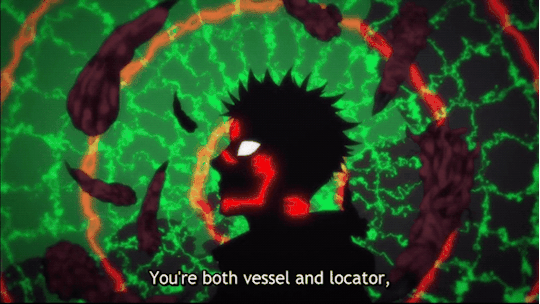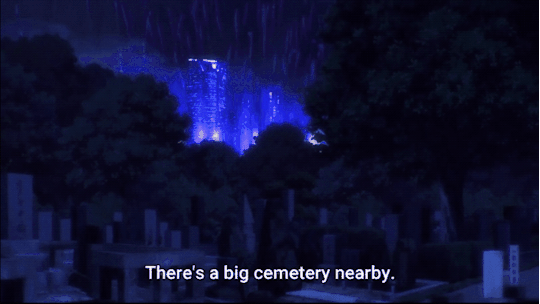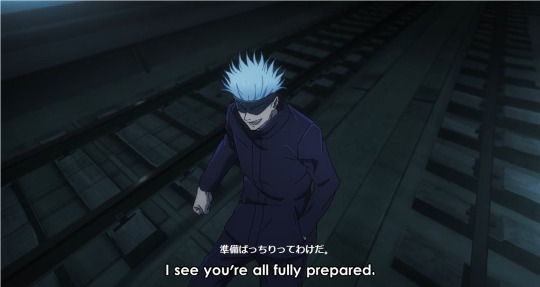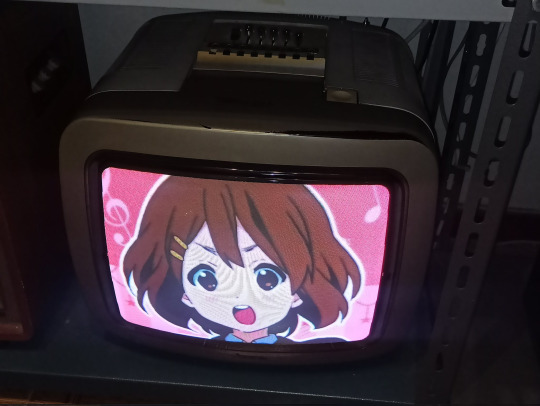#わけ
Explore tagged Tumblr posts
Text
わけ - definition (2)
What does ~わけ mean?
The same post in much higher quality is here
In this #Japanese with anime post, we will take a closer look at a mind-bending structure belonging to the realm of modality and, unfortunately, is usually omitted in translation. It's not that it has to be omitted; it happens that English just sounds better or makes sense without it (in most cases).
Examples in this post are from Jujutsu Kaisen Season 1 and Season 2.
Extra grammar:
というわけ vs. わけ
わけ vs. から/ので
Before we dive in
わけ is truly a mind-bending structure, and knowing just the dictionary definition is not usually enough. The examples provided in textbooks seem to be okay at first glance, but when you start analyzing and comparing わけ to other structures and grammar points, you quickly realize that you haven't fully grasped the concept it actually represents.
Long story short, though. In a lot of cases, わけ can be translated to 'so' or 'then' (: as a necessary consequence; Merriam-Webster).
However, in many cases, English translations don't need to include 'so' or 'then' because things can be simply understood from the context. As readers, we don't need extra lexical help to understand that something is a consequence of something else. The brain fills in that information naturally on its own. Japanese, though, decided that having extra lexical help could be useful.
Note: This article doesn't explain the meaning of structures like わけにはいかない or わけではない. They do have their English equivalents.
I also managed to compile a short list of things that literally enlightened me while struggling to understand what わけ really means and why we need it to sound natural.
In many contexts, わけ indicates that the partners in the conversation share some knowledge.
You really need context to be able to use it. If you were to just enter a room and say a sentence containing わけ, it wouldn't make much sense.
It is used as a reaction/to react to someone else's statement (dialog) or to your surroundings. It shows that you have realized/understood something. Could be paired with だから, それで、なるほど, which are placed at the beginning and わけ at the end, for example:
だから、五条先生強いわけだ。
Ah, so that's why Gojo-sensei is so strong.
Context: We were wondering why Gojo is so strong, and we just found out (someone told us) that Gojo is a six-eye user, and that made us realize why he is so strong.
It is used when the speaker performs a monologue. In this case, we can distinguish two possible situations:
emphasizing inevitable consequences of some actions, i.e. You eat a lot of sugar, so naturally you will gain weight. If you don't add わけ to such a statement, it will be fine as well, but it will sound like a dry fact. However, during a lecture or a conversation about eating habits and their consequences adding わけ will give your sentence the nuance of "And as you know...".
the speaker wants to restate/sum up their own words because their first explanation was unclear. It's like saying "I mean..."; "In other words..."
It is used to restate/paraphrase someone else's words (or your own words). Could be paired with つまり. For example, someone described something to you, but it was complicated. You want to make sure you understand the statement correctly, so you paraphrase it using easier words. You will end that 'easier' sentence with わけ or というわけ.
Used to give the reason for what the conversation partner has said or to state the logical conclusion. Remember that both parties in the conversation need to have the same knowledge. For example:
Context: Both of the speakers knew that Tanaka-san had some heart problems, and one of them drew a logical concl
田中さんが亡くなったそうだ.
I have heard that Tanaka-san has died recently.
本当?心臓発作だったというわけだな。
Really? That must have been a heart attack. (source) usion.
わけではない is used for correcting false impressions
In English, the tone of your voice and intonation will change the meaning of your sentence. In Japanese, though, such changes can be expressed through particle/verb ending choice. A good example can also be ~てしまう.
Consider this sentence:
I didn't invite him to the party because I didn't like him.
It could mean either: 1. I don't want to party with people I don't like. (から) 2. I had other reasons not to invite him, and not liking him wasn't one of them (わけではない)
Even though there are ways to translate わけ into English, it's often omitted in translations.
'Because ' in English is used to provide reasons, but it doesn't really matter if your conversation partner shares knowledge with you. 'Because' can convey completely new information or information already known to everyone for clarity's sake. わけ, on the other hand, speakers must have some prior, common knowledge.
In the following parts of the article, you will find more information related to the above points.
Definition of ~わけ
According to Jisho, it is a noun, and because it is a noun you negate it as a noun, and it conveys the meaning of:
conclusion from reasoning,
judgment or calculation based on something read or heard;
or it just translates to (as a standalone word)
reason; cause; meaning; circumstances; situation.
Stefan Kaiser in his book Japanese: A Comprehensive Grammar defines わけ as
a structural noun [...] used when the speaker realizes that there is an explanation or reason for some occurrence or phenomenon. Or [...] used when the speaker realizes that some fact or occurrence is the result of some other fact or occurrence.
The author mentions that it can be translated to 'so' or 'then'. Following this definition, let's analyze our first example from Jujutsu Kaisen.
JJK; S01 episode 02 or 03; Yuuji just moved into the school dorms

君の中の宿儺が力を取り戻すために指の在り処を教えてくれる. 君は器である同時に探知機、レーダーでもあるわけだ.
To regain its power, the Sukuna you consumed will direct you to the whereabouts of the fingers. You are a vessel as well as a radar.
To better understand this sentence, let's look at more context.
Yuuji has already eaten two of Sukuna's fingers. Since the fingers resonate with each other, he can kind of guess where they are or at least sense their presence (to some degree). Given those facts, we can surmise that Yuuji works like a radar, and that is what Gojo implies by using わけ.
In essence, わけ marks a logical conclusion or result based on some known facts.
Some known facts: Yuuji ate the fingers, they resonate with each other, and he's a vessel...
The conclusion from reasoning/realization: ...you’re a radar.
Notice that the English translation��did not include any phrase that would introduce 'conclusion'. It is implied. You could include, for example, 'And that's why...' or something along those lines, but the whole line sounds better without it.
Let's elaborate on it, though. For those of you who don't overthink life or grammar rules, such short dictionary entries might be enough, but I'm a professional overthinker and I just need to know.
~わけ as a modal structure
This section is full of proper linguistic discourse, but don't shy away from it. It might actually help you deepen your understanding of this structure. Japanese grammar books for teachers, and grammar books written in Japanese, list わけ as a modal structure.
For a complete guide to modality, go here ⇒ Link Click
Modality is about a speaker’s or a writer’s attitude towards the world. A speaker or writer can express certainty, possibility, willingness, obligation, necessity and ability by using modal words and expressions. Speakers often have different opinions about the same thing. (Cambridge online dictionary)
Simply put, modal structures help you convey a variety of subjective nuances, for example, instead of saying, I'm wrong, you can say, I might be wrong (might is a modal verb). Let's see what subjective feelings わけ helps us convey:
Certainty or Conviction: わけ is often used when the speaker is confident or certain about the reason they are presenting. It signals that the speaker believes something is true based on their understanding or recognition of a situation.
Explanatory or Justificatory: It is commonly used to explain or justify a statement or action. It adds a sense of "it makes sense that..." or "therefore..." to the statement, showing that the speaker is not just stating a reason but also expressing their conviction or perspective on that reason.
Subjective Interpretation: わけ reflects the speaker's subjective interpretation or understanding of a situation, making it a modal structure because it conveys the speaker's attitude and belief.
An interesting observation has been made in an article titled 「わけだ」文と「からだ」文の意味の違いについて by 牟世鍾 and 宋洙珍 (I'm sorry, I can't decipher their names).
「わけだ」文が表す理由は、対象から納得し、それを理由として位置づけたもの、つまり、話し手が何か認識の過程を経て位置づけたまさにモダリティの形式であり、そのような認識․納得の過程のない直接���な理由を表す「からだ」文とは異なっている。
Which roughly translates to:
The reason expressed by the sentence わけだ is that the speaker is convinced by the object and positions it as the reason, that is, it is the very form of modality that the speaker positions through some recognition process, which is different from the sentence からだ, which expresses direct reasons without such a recognition/convincing process. (translation: mine)
In summary, the passage explains that わけだ places emphasis on the speaker's mental activity by which they become aware of, identify, and understand something (recognition). It involves perceiving, acknowledging, and comprehending information or stimuli in a way that leads to an understanding or recognition of a particular fact, concept, or situation. からだ, on the other hand, is more direct and simply states the reason without highlighting the speaker's internal thought process.
The article also states that
納得の形で提示した理由の文、つまり「わけだ」文は「からだ」文に置き換えられるが、その「からだ」文は「わけだ」文が持っているモダリティ的な意味はなく、単なる理由を表す文になってしまう。
Which translates to:
The statement of reason presented as a form of belief, i.e., the わけだ statement, can be replaced by the からだ statement, but this からだ statement does not have the modality meaning of the わけだ statement and becomes a mere statement of reason.
"A mere statement of reason" refers to a straightforward and explicit connection between the cause and reason; there's no room for confusion or subjective interpretations. Modality, though, is all about subjective interpretations. For example, in the sentence "I'm late because of traffic," "because of traffic" directly links the cause (traffic) to the effect (being late), making it clear that traffic is the reason for being late. There is a straightforward connection between the two elements.
Okay, let's leave modality and that linguistic talk and move on to something lighter. However, continue reading this article to find out what is the best possible interpretation of Gojo's わけ.
A learner-friendly definition of わけ
After many talks with my Japanese teacher, we managed to pinpoint some reasons for using this structure and what speakers want to convey by using it. Our main goal was to determine why in some cases わけ is a much better option than から.
Let's go back to our Jujutsu Kaisen example:
君の中の宿儺が力を取り戻すために指の在り処を教えてくれる. 君は器である同時に探知機、レーダーでもあるわけだ.
To regain its power, the Sukuna you consumed will direct you to the whereabouts of the fingers. You are a vessel as well as a radar. (official translation)
In this case, and as you will see in other examples, わけ most likely conveys:
general/obvious statement. It means that all parties involved in the conversation share the same knowledge and the speaker just confirms everyone's understanding.
the speaker indirectly (through わけ ) asks "You understand, right?" / "You know what that means, right?"
Gojo realizes that Yuuji has enough information to understand his situation, but may or may not know the implications. Yuuji may not know/be sure what all of this means.
Gojo first provided Yuuji with a result and then he stated the reason why achieving this result will be possible. This can also give わけ the meaning of "So no wonder why you work like a radar."
In essence, わけ is used when there is shared knowledge about the situation and the speaker reinforces/confirms everyone's understanding, even when not prompted to do so. If we replace わけ with から, we will end up with a sentence conveying completely new information to Yuuji. The context of this sentence would have to be different as well.
The original context involves Gojo walking Yuuji around the school and talking to him about the jujutsu world and Yuuji's position in all of this. Yuuji did not ask any questions during their walk, as some things had been explained to him before.
However, if Yuuji was oblivious to his situation and what having eaten the fingers meant for him and the jujutsu world, Gojo would have to provide him with some dry explanations/facts. The important factor here is 'being oblivious/not knowing enough'.
Let's replace わけ with から then.
[...] 君は器である同時に探知機、レーダーでもあるから。
To regain its power the Sukuna you consumed will direct you to the whereabouts of the fingers. Because you are a vessel, a locator as well as a radar.
In English, it still might make sense, but as I mentioned at the very beginning, わけ is often omitted in translation. In translation, we call such cases 'problems with equivalence', which means that one language has something that the other doesn't have or doesn't use it as often as the first one. If Gojo used から, it would imply that Yuuji didn't know that he was a vessel, that the fingers resonate with each other, and therefore he could be of help to everyone. The exchange between them could look like this: Gojo: In order to regain its power the Sukuna you consumed will direct you to the whereabouts of the fingers. Yuuji:Why? / How come? Gojo: Because you are a vessel, a locator as well as a radar. Let's analyze another example from Jujutsu Kaisen. Nobara just joined the team; S01; Ep03

でかい霊園があってさ、廃ビルとのダブルパンチで呪いが発生したってわけ
There is a big cemetery, and the double whammy with the abandoned building caused the curse. (Again, no English equivalent of わけ)
というわけだ / ってわけだ are just more elaborate ways to express logical conclusions. It's often used with な-adj and nouns. There's a separate section on that, too.
In this case, Gojo gave our main trio two reasons why the curse might have shown up in the abandoned building. The building and the nearby graveyard are those reasons.
If we were to explain the use of わけ here in linguistic terms, we could say that わけ is used to emphasize that the occurrence of the curse is the logical result of the combination of two factors: the large cemetery and the abandoned building. It suggests that there's a logical connection between these two elements that led to the curse. It also adds a sense of logical inevitability.
However, explaining it through our 'learner-friendly definition' we could say that Gojo used it because:
all of them share the same knowledge, namely they all know why curses are born and what the combo of an abandoned building and a graveyard means (general/obvious statement).
It's not like they pulled up to the building oblivious to the world around them, and Gojo had to teach them the basics. Even though they did not ask any questions, he was confirming their understanding of the situation through わけ.
Gojo through わけ also implies something along the lines of "And as you can see..." or "As you probably already realized..."
It could also be the case that they immediately realized that the curse was there, but they didn't know why/weren't sure why. Gojo did not waste time, and instead of waiting for their questions, he supplied the missing information himself.
If we modified the sentence with から, it would still indicate that the curse occurred because of the combination of the large cemetery and the abandoned building. However, it would imply that the main trio didn't know that the connection between the curse being there and the vicinity of the graveyard and abandoned building mattered.
The conversation could go like this: Gojo: There's a curse in this building. Them: Why? Gojo: There is a big cemetery, and the double whammy with the abandoned building caused the curse. One more example from Season 1, Episode 2.

さすがに特級呪物が行方不明となると―上がうるさくてねえ 観光がてら はせ参じたってわけ
As one would expect when a special-grade cursed object goes missing, the higher-ups won't shut up, so I stopped by while I was out for some sightseeing.
In this case, 'so' perfectly captures the meaning of わけ, as Stefan Kaiser pointed out in his book.
A missing special grade cursed object is a big deal and sorcerers shouldn't take such cases lightly, which Gojo points out to Fushiguro, namely "[...] the higher-ups won't shut up."
Both Gojo and Fushiguro know about it as they belong to this community, which means they share knowledge.
While Gojo is telling Fushiguro why he came, he isn't providing him with new information. In this case, わけ has the nuance of "So you probably realize why I am here."
Because they belong to the same community, Fishuguro understands that ignoring special-grade cursed objects isn't the best of actions, and Gojo just reinforces/confirms his understanding.
One example from Season 2, Episode 8

準備ばっちりってわけだ。
The presence of わけ in this example might not be so clear at first glance. However, the English translations official and unofficial alike somehow manage to capture the meaning of わけ through "I see," which by many learners is instinctively translated to なるほど, though.
As always, we need more context.
Gojo since entering the Shibuya station began to collect information about the situation. He noticed some things that helped him understand/realize what was going on, namely his opponents (Jogo, Hanami, and Choso) prepared for the fight with him.
Through わけ, Gojo shows his realization. At the beginning of this article, I mentioned that わけ can be used as a reaction to someone else's statement. In this case, Gojo is not reacting to someone else's words, but to his surroundings.
In an alternate situation, Jogo or Hanami could also tell him: "Hey! We did this and that!" And Gojo could reply with: "Is that so? It means that you prepared yourself then" (drawing a logical conclusion/natural consequence).
Summary
So let's summarize what we have learned about わけ so far.
わけ is a modal structure, which means that the statements marked by it aren't facts but opinions/beliefs/thoughts.
It can be used interchangeably with から, but the nuance changes, and in some cases the meaning.
It marks logical conclusions, which by nature aren't hard facts.
It can also be used to give advice or make general statements based on a logical conclusion.
というわけだ is a more formal and elaborate way to provide a conclusion because there are more reasons stated and this helps us summarize everything.
わけ is used to explain the reason or cause behind something. It helps clarify why a certain situation occurred or why someone did something.
It is often used to provide an explanation or justification.
All parties involved in the conversation share some knowledge / have the same information.
You can't really use it without context, as opposed to から, which can be used without any context.
It conveys the nuance of "As you probably already realized..." or indirectly asks, "You understand, don't you?"
というわけだ / ってわけだ for restating some facts
Apart from というわけだ / ってわけだ being a "more elaborate way to mark logical conclusions", it can also be defined as a structure that paraphrases someone else's or your own words.
わけだ and というわけだ don't really change the meaning of the sentence, but というわけだ is used when the speaker provides more than one reason for something. It is often used with な-adjectives and nouns as opposed to わけだ, which is often seen after verbs. It's not a hard rule, though.
What does paraphrasing mean and why do we do that?
Paraphrasing means that you're trying to use your own words to show how you understand someone's statement. You have analyzed someone's statement and you drew a conclusion.
We do it because we are not sure of our understanding; in a way, we're asking our speaker to confirm our understanding. Modal meaning applies here as well.
In the previous examples, Gojo wasn't restating someone else's words. He was the one to introduce the information.
However, in the example below, Principal Yaga is restating Yuuji's reasons for joining the jujutsu world.
The interview with Yaga; S01; Ep02

それが呪いの被害となると看過できないというわけか
Yaga just asked Yuuji why he wanted to join the jujutsu high school. Yuuji told him that leaving Sukuna's fingers as they are (unprotected/unsupervised) is dangerous. Yaga drew a conclusion from that, namely:
JJK; Chapter 3; Viz Media

In this case, we actually have something that is considered the equivalent of というわけだ namely, "So you're telling me that [...]". However, remember that not every "so you're telling me that..." needs to be translated to というわけだ.
In the very first chapter, the very first thing Fushiguro says to Gojo is, "You're telling me that someone is keeping a special-grade cursed object in a place like this?!" Fushiguro wasn't restating/paraphrasing Gojo's words.
We can assume that before this panel Gojo told Fushiguro: "There's a special-grade cursed object in the outdoor thermometer box." Fushiguro saw it and just repeated Gojo's words in disbelief, it was sort of a quotation.
Translation problems
In the above examples, わけ could be translated to 'so' or 'then,' but the aim of translation is to make sentences in the target language sound as natural as possible. We could rephrase all of them and include 'so' or 'then' or even any other synonyms, but if the context is clear enough, then including extra lexical help is simply redundant.
Here, we're also dealing with audiovisual translation, where the number of characters in a single line of subtitles matters a lot. Too many words in a single line may hinder the understanding or slow it down and lower the overall experience. And yes, even such short words as 'so' can do it.
Sources
https://briefjapanese.fun/how-to-use-wake/
my Japanese teacher and his native Japanese teacher
Stefan Kaiser, Japanese: A Comprehensive Grammar (p.285)
7 notes
·
View notes
Text


けんけん
1K notes
·
View notes
Text


3K notes
·
View notes
Text




˖𓄰 ֗ ׅ˖་⊹. 🎀🌟🌈˖𓄰 ֗ ׅ˖་⊹. 🎀🌟🌈˖𓄰 ֗ ׅ˖་⊹. 🎀🌟🌈
˖𓄰 ֗ ׅ˖་⊹. 🎀🌟🌈˖𓄰 ֗ ׅ˖་⊹. 🎀🌟🌈˖𓄰 ֗ ׅ˖་⊹. 🎀🌟🌈
˖𓄰 ֗ ׅ˖་⊹. 🎀🌟🌈˖𓄰 ֗ ׅ˖་⊹. 🎀🌟🌈˖𓄰 ֗ ׅ˖་⊹. 🎀🌟🌈
#アニメ#かわいい#⊹ ⋆꒰ఎ ♡ ໒꒱ ⋆゚⊹#💙⭑ ˙₊⁺𓈒 ࣪˖ ִֶָ ˙⁺ ࣪˖⭒ ִֶָ˙ 𓈒 ࣪˖ ִֶָ ˙₊⁺ 𓈒 ࣪꙳˖ ִֶָ💙#🎀。゚・。゚ᐠ( ᐢ ᵕ ᐢ )ᐟ。゚・。゚🎀#けいおん!#anime#kawaii#animecore#otakucore#webcore#kawaiicore#gif#old web#2010s#old anime#video game#game#k-on#k-on!#k on#k on!#00s#2000s#pinkcore#neetcore#otaku#nostalgiacore#internetcore#softcore
2K notes
·
View notes
Text

8-23-2024
693 notes
·
View notes
Text

520 notes
·
View notes
Text


☆.。.:* .。.:*☆☆.。.:* 🌊 .。.:*☆☆.。.:*
🐬☀️イルカゼリーデコレーション ~☀️🐬
『キラキラ☆プリキュアアラモード』~
☆.。.:* .。.:*☆☆.。.:* 🌊 .。.:*☆☆.。.:*
#🎀。゚・。゚ᐠ( ᐢ ᵕ ᐢ )ᐟ。゚・。゚🎀#⊹ ⋆꒰ఎ ♡ ໒꒱ ⋆゚⊹#☘️🎀· ˚ 。🌈・ 。゚⭐️かわいい世界🌈・ 。゚⭐️ · ˚ 。🎀☘️#˚˖𓍢ִ໋🍮✧˚.🎀༘⋆「 ✦ 𝖕𝖗𝖎𝖓𝖈𝖊𝖘𝖘𝖆𝖓𝖙𝖎𝖘𝖔𝖈𝖎𝖆𝖑 ✦ 」୧ ‧₊˚ 🍓 ⋅ ☆#可憐#可愛い#かわいい#夏に向けたレシピ#my gifs#precure#aesthetic#kawaii#kawaiicore#jojifuku#webcore#weebcore#otakucore#animecore#neetcore#moecore#recipes#summer#summercore#tropical#tropicalcore#キラキラ☆プリキュアアラモード#KiraKira☆PreCure A La Mode!#2010s#2010s nostalgia#oceancore
800 notes
·
View notes
Text

"あけましておめでとうございます"
happy new year 2025
#art#design#drawing#illustration#illust#illustrator#original#original art#happynewyear#new year 2025#2025#yuki kawatsu#絵#イラスト#イラストレーション#イラストレーター#オリジナル#オリジナルイラスト#年賀状#新年#2025年#巳年#あけましておめでとうございます#かわつ ゆうき
288 notes
·
View notes
Text


#アニメ#⊹ ⋆꒰ఎ ♡ ໒꒱ ⋆゚⊹#かわいい#🎀。゚・。゚ᐠ( ᐢ ᵕ ᐢ )ᐟ。゚・。゚🎀#可憐#キュート#可愛い#俺妹#俺の妹がこんなに可愛いわけがない#animecore#anime#otakucore#webcore#kawaiicore#kawaii#weebcore#ore no imouto ga konna ni kawaii wake ga nai#oreimo#nostalgiacore#moecore#kousaka kirino#高坂 桐乃#pinkcore#gif#jojifuku
774 notes
·
View notes
Text
しくみや中身がわかると、わけがわかり、楽しくなったりする。 ゲームも、ギャンブルも、ペットも、庭も、趣味も、スポーツも、勉強も、仕事も、政治経済談義も、オタク談義も、旅行も、衣食住も、人も、人生も。 しくみや中身がわかるには、たいてい手間ヒマがかかる。
0 notes
Text

けんけん
1K notes
·
View notes
Text




2K notes
·
View notes
Text

🎉🎅🎄✩‧₊˚けいおん!CHRISTMAS✩‧₊˚🎄🎅🎉
#⠀ 🎄 ⊹︵︵︵ ⊹ ୨୧ ⊹ ︵︵︵ ⊹ 🔔#🎁 ˚ ༘♡ ⋆。˚ㅤ 淡紅色 ㅤ ㅤ꒰ 🎄 ꒱ ⠀⠀⠀⠀イ. ₊ ˚ ׅ ㅤ🎅 。˚ ◟#けいおん!#アニメ#かわいい#⊹ ⋆꒰ఎ ♡ ໒꒱ ⋆゚⊹#k-on#k-on!#jojifuku#k on#k on!#animecore#otakucore#webcore#kawaiicore#old web#2010s#old anime#可憐#pinkcore#merry christmas#xmas#anime christmas#可愛い#キュート#anime#kawaii
479 notes
·
View notes
Text

.˚ · ☆(๑ᵔ 3 ᵔ๑).˚ · ☆.˚ · ☆(๑ᵔ 3 ᵔ๑).˚ · ☆.˚ · ☆(๑ᵔ 3 ᵔ๑).˚ · ☆
#🌙🌠⭐️ ‧₊˚ ⋅⋅˚ ๑‧˚₊˚ ๑‧˚₊꒷︶🌃🌒︶꒷꒦⊹๑‧˚₊🌙🌠⭐️.・✫・#🌆🌙✨ ⊹︵︵︵ ⊹ ୨୧ ⊹ ︵︵︵ ⊹ 🌆🌙✨#アニメ#かわいい#甘い#⊹ ⋆꒰ఎ ♡ ໒꒱ ⋆゚⊹#可憐#キュート#可愛い#jojifuku#anime#animecore#otakucore#kawaii#kawaiicore#webcore#weebcore#2000s core#2000s#00s#vn#visual novel#game cg#夜明け前より瑠璃色な#Yoake Mae yori Ruri Iro na#夜明けな#けよりな#Brighter than Dawning Blue
165 notes
·
View notes
Text
studio obake
make the micro music and short animation.
studioOBAKE https://studio-obake.com/
#ghost#short animation#micro music#chillout#lo-fi animation#lo-fi music#original character#character#obake#studio obake#cute#kindness#おばけ#かわいい#やさしい
697 notes
·
View notes